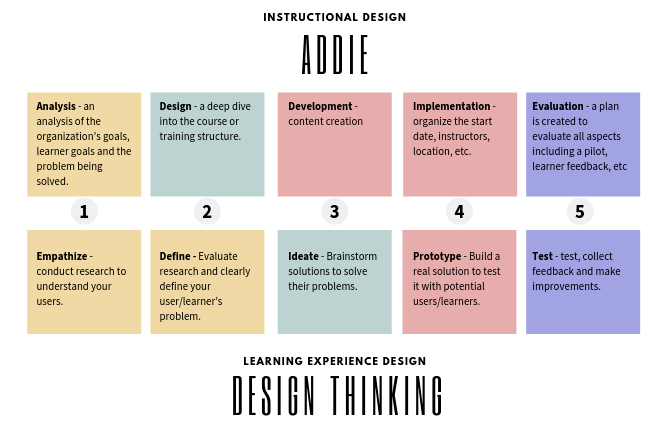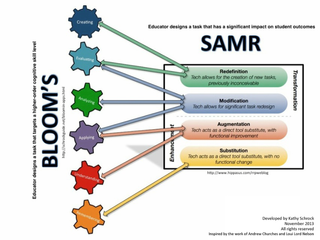ID, UX and LXD: Differences and Similarities Explained
https://www.linkedin.com/pulse/id-ux-lxd-differences-similarities-explained-sonia-tiwari/
LXD Learning Experience Design
UX User Experience Design
ID Instructional Design
Niels Floor‘s highly informative articles on lxd.org
Instructional Design focuses on instruction, User Experience Design focuses on the user, and Learning Experience Design focuses on the learner. This is not to say that IDs don’t care about learners, or that UX designers do not work on educational products, or that LXDs spend no time thinking about instruction or users. The difference lies in who these designers orient their process towards the most – instruction, user, learner.
history of ID at Instruction Design Central.
more about the origins of UX in this article in Career Foundary by Emily Stevens or this brief intro to HCI in Interaction Design Foundation by John Carroll. If you’re curious, learn about what Don Norman thinks of UX today.
ID as a field tends to be more scientific and organized, following academic frameworks
UX tends to be both scientific and artistic in its approach. UX designers are informed by academic theories and frameworks, but are also flexible and artistic in finding engaging, intuitive solutions to usability issues.
LXD tends to be more artistic than scientific. While LX designers care about the learning process deeply though understanding of related learning theories and cognitive processes of learners, their primary focus is on designing visually stunning, useful, and engaging learning experiences.
IDs are typically working on products such as Courses, e-learning modules, curriculum, workshops. UX designers are typically working on products such as mobile apps, websites, digital games, software. LXDs are typically working on all these things – courses, apps, AND other forms of learning experiences which could take the form of museum exhibits, summer camps, AR interactive booklets, children’s books, movies, toys and games or any other medium that can be used to generate a learning experience.
Indeed.com
software tools are just like paintbrushes, they don’t make an artist. Some popular paintbrushes for IDs are Adobe Captivate, Articulate Storyline, Brainshark. For UX designers some popular tools are Adobe XD, Sketch, Figma, Balsamiq. For LXDs everything Adobe Creative Cloud has to offer – and many other ID/UX tools as well (depending on what the experience design needs) come in handy.
For IDs, one of the popular frameworks is ADDIE: Analyze, Design, Development, Implement, Evaluation
For UX designers, a popular framework quoted often is Design Thinking: Empathize, Define, Ideate, Prototype, Test
For LXDs, Neils floor outlines this LXD process: Question, Research, Design, Build, Test, Improve, Launch
+++++++++++++++++
more on ID instructional design in this IMS blog
https://blog.stcloudstate.edu/ims?s=instructional+design
Mayer’s 12 Principles of Multimedia
How to Use Mayer’s 12 Principles of Multimedia Learning [Examples Included]
1. The Coherence Principle
2. The Signaling Principle
3. The Redundancy Principle
humans learn best with narration and graphics, as opposed to narration, graphics, and text.
4. The Spatial Contiguity Principle
learn best when relevant text and visuals are physically close together
5. The Temporal Contiguity Principle
learn best when corresponding words and visuals are presented together, instead of in consecutive order.
6. The Segmenting Principle
learn best when information is presented in segments, rather than one long continuous stream.
7. The Pre-Training Principle
learn more efficiently if they already know some of the basics.
8. The Modality Principle
learn best from visuals and spoken words than from visuals and printed words.
9. The Multimedia Principle
learn best from words and pictures than just words alone.
10. The Personalization Principle
learn best from a more informal, conversational voice than an overly formal voice.
11. The Voice Principle
learn best from a human voice than a computer voice.
12. The Image Principle
humans do not necessarily learn better from a talking head video.
++++++++++++++
more on ID in this IMS blog
https://blog.stcloudstate.edu/ims?s=instructional+design
https://www.facebook.com/groups/onlinelearningcollective/permalink/603803423583693/
Anyone in here teach instructional design that can recommend a textbook that teaches ADDIE or SAM but is inclusive and has an emphasis on instruction being culturally responsive or culturally sustaining?
Glenn Singley
https://community.articulate.com/articles/an-introduction-to-sam-for-instructional-designers
The ADDIE model of instructional design is probably the most well-known approach for crafting learning solutions. ADDIE stands for Analyze, Design, Development, Implement, and Evaluate. But ADDIE isn’t the only game in town these days. One popular alternative to ADDIE is SAM, which stands for Successive Approximation Model.
Created by Allen Interactions, SAM offers an instructional design approach consisting of repeated small steps, or iterations, that are intended to address some of the most common instructional design pain points, like meeting timelines, staying on budget, and collaborating with Subject Matter Experts
++++++++++++
more on ADDIE in this IMS blog
https://blog.stcloudstate.edu/ims?s=addie+model
https://blog.stcloudstate.edu/ims?s=SAMR
Building a Learning Innovation Network
https://www.insidehighered.com/digital-learning/blogs/technology-and-learning/building-learning-innovation-network
a new interdisciplinary field of learning innovation emerging.
Learning innovation, as conceptualized as an interdisciplinary field, attempts to claim a space at the intersection of design, technology, learning science and analytics — all in the unique context of higher education.
professional associations, such as POD, ELI, UPCEA, (https://upcea.edu/) OLC (https://onlinelearningconsortium.org/), ASU GSV (https://www.asugsvsummit.com/) and SXSW Edu (https://www.sxswedu.com/) — among many other conferences and events put on by professional associations.
A professional community of practice differs from that of an interdisciplinary academic network. Professional communities of practice are connected through shared professional goals. Where best practices and shared experiences form the basis of membership in professional associations, academic networks are situated within marketplaces for ideas. Academic networks run on the generation of new ideas and scholarly exchange. These two network models are different.
+++++++++++
https://elearningindustry.com/learning-experience-design-instructional-design-difference
“Learning Experience Design™ is a synthesis of Instructional Design, educational pedagogy, neuroscience, social sciences, design thinking, and User Experience Design.”
The Process: ADDIE Vs. Design Thinking

++++++++++++++
more on LX design in this iMS blog
https://blog.stcloudstate.edu/ims?s=learning+design



